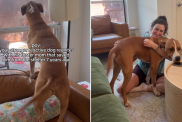The simple act of holding still is a huge challenge for some dogs, especially wriggly young pups. To teach a rock-solid stay, start small and make it easy for your dog to get it right. For an energetic young puppy, that may mean half-second stays. That’s fine–from half a second you can build to one second, then two, and on from there. Many short, successful stays are better for your dog’s obedience skills than a long stay that ends with wandering dog and a frustrated owner.
How to teach “stay”
- Start in a spot that’s familiar to your dog, without any tempting distractions around. Keep your dog focused on you by standing right in front of her, giving her your full attention, and looking her in the eye. With a treat in your hand, ask your dog to sit or lie down.
- If your dog holds the position for a second or two, praise her and give her a treat.
- Repeat the process, this time making your dog hold the position for a few seconds longer before you give her the treat.
- Once your dog is responding reliably, add the verbal cue. Ask your dog to sit or lie down, then tell her “stay,” holding your hand out with your palm toward her nose in the “stop” position. If she holds the position for a second or two, praise her and offer a treat. Repeat the sequence, gradually tacking on a second or so each time to ask for a longer stay.
If it’s not working
The moment your dog breaks the stay, say “SIT! Stay” or “DOWN! Stay,” depending on which position she was originally in. Then try again for a shorter stay.
If you’ve been practicing for a while and your dog knows the stay command, you can make your voice sharp, like a reprimand, when she’s moving out of position. But don’t punish: by the time you catch up with your dog, she’s already broken the stay, and she’ll associate the punishment with what she was doing at the moment you punished her–allowing you to catch her–not with breaking the stay. That’s not what you want.
Advanced “stay”
Once your dog has the hang of the “stay” command, you can slowly make it more challenging. Stand a foot away from your dog when you ask her to stay, then two feet away, and keep increasing the distance. Ask her to stay when your back is turned; when there’s another person or dog in the distance, then fairly close by, then right next to your dog; when you’re bouncing a ball; when there’s kibble scattered around her; and so on.
Add a new challenge only if your dog is responding reliably. If your dog ever breaks a stay, take away a challenge–make the stay shorter, remove the distractions, or stand closer to her–and try again.









